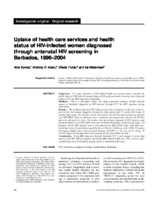Uptake of health care services and health status of HIV-infected women diagnosed through antenatal HIV screening in Barbados, 1996-2004
Date
2007Metadata
Show full item recordAbstract
OBJECTIVES: To study utilization of HIV-related health care services and to describe the health status of HIV-infected women diagnosed through antenatal voluntary counseling and testing (VCT) for HIV infection in Barbados. METHODS: This is a descriptive study. The study population includes all HIV-infected women in Barbados diagnosed as HIV-infected through VCT for HIV infection during 1996-2004. RESULTS: The median duration of HIV infection from time of diagnosis to the time of this report for the 163 women diagnosed during the study period was 72 months (low range, 9 months; high range, 117 months). Of the 163 women, 102 (62.6 percent) had attended the centralized HIV/AIDS clinic for follow-up (care, treatment, and monitoring), whereas 61 (37.4 percent) had never attended the clinic. The median time lag between diagnosis of HIV infection and first presentation to the HIV/AIDS clinic was 36 months (low range, 1 month; high range, 114 months). Of the HIV-infected women who attended the HIV/AIDS clinic, more than one-fourth had severe immunodeficiency at the time of their first follow-up visit. Of the 53 women undergoing highly active anti-retroviral therapy (HAART) at the time of the study, 23 (43.4 percent) began the therapy within three months of their first follow-up visit. CONCLUSIONS: Early HIV diagnosis through antenatal VCT is not enough to ensure that women with HIV will get adequate and timely HIV-related health care. These women suffer significant premature mortality, largely related to inadequate follow-up.(AU) OBJETIVOS: Estudiar la utilización de los servicios de atención sanitaria relacionados con el VIH y describir el estado de salud de las mujeres infectadas con este virus, diagnosticadas mediante el asesoramiento y la prueba de detección del VIH de carácter voluntario (APDV) durante el período prenatal en Barbados. MÉTODOS: Este es un estudio descriptivo. La población de estudio abarcó a todas las mujeres infectadas por el VIH, diagnosticadas en Barbados mediante el APDV en 1996-2004. RESULTADOS: La mediana de la duración de la infección por el VIH -desde el diagnóstico hasta el momento de este informe- en las 163 mujeres diagnosticadas durante el período de estudio fue de 72 meses (nivel bajo: 9 meses; nivel alto: 117 meses). De las 163 mujeres, 102 (62,6 por ciento) asistieron a la clínica centralizada para el VIH/sida para su seguimiento (atención, tratamiento y monitoreo), mientras que 61 (37,4 por ciento) nunca asistieron a la clínica. La mediana del lapso entre el diagnóstico de la infección por el VIH y la primera presentación a la clínica para el VIH/sida fue de 36 meses (nivel bajo: 1 mes; nivel alto: 114 meses). Más de la cuarta parte de las mujeres infectadas que acudieron a la clínica presentaban inmunodeficiencia grave en el momento de su primera consulta de seguimiento. De las 53 mujeres que se sometieron al tratamiento antirretroviral de gran actividad (HAART) durante el estudio, 23 (43,4 por ciento) comenzaron el tratamiento en los tres meses siguientes a su primera visita de seguimiento. CONCLUSIONES: El diagnóstico temprano mediante el APDV no garantiza que las mujeres con VIH reciban una atención adecuada y oportuna para tratar esa infección. Estas mujeres sufren una mortalidad significativamente prematura, en gran parte debido al inadecuado seguimiento.(AU)
Subject
URI
http://www.scielosp.org/scielo.php?script=sci_arttext&pid=S1020-49892007001100002https://iris.paho.org/handle/10665.2/7757
Citation
Kumar, Alok,Kilaru, Krishna R,Forde, Sheila,Waterman, Ira (2007) Uptake of health care services and health status of HIV-infected women diagnosed through antenatal HIV screening in Barbados, 1996-2004. Rev Panam Salud Publica;22(6) 376-382,dic. 2007. Retrieved from http://www.scielosp.org/scielo.php?script=sci_arttext&pid=S1020-49892007001100002
Collections
Related items
Showing items related by title, author, creator and subject.
-
Rose, Angela M.; Hambleton, Ian R.; Jeyaseelan, Selvi M.; Howitt, Christina; Harewood, Rhea; Campbell, Jacqueline; Martelly, Tanya N.; Blackman, Tracey; George, Kenneth S.; Hassell, Trevor A.; Corbin, David O.; Delice, Rudolph; Prussia, Patsy; Legetic, Branka; Hennis, Anselm J. (2016)Objective. To describe the surveillance model used to develop the first national, populationbased, multiple noncommunicable disease (NCD) registry in the Caribbean (one of the first of its kind worldwide); registry ...
-
Pan American Health Organization (PAHOUnited StatesWashington, D.C, 2008)[Executive Summary]. Barbados is an independent democratic country in the Caribbean with a mid-year population estimated at 275,000 in 2007 occupying 166 square miles; it is one of the most densely populated countries in ...
-
Pan American Health Organization; Barbados and the Eastern Caribbean Countries (ECC) (PAHOBarbadosBridgetown, 2022)The situation in some countries and territories (hitherto referred to as countries) follows the trend from last week of peaks in the current Omicron wave having been reached and declining cases & hospitalizations. This ...




